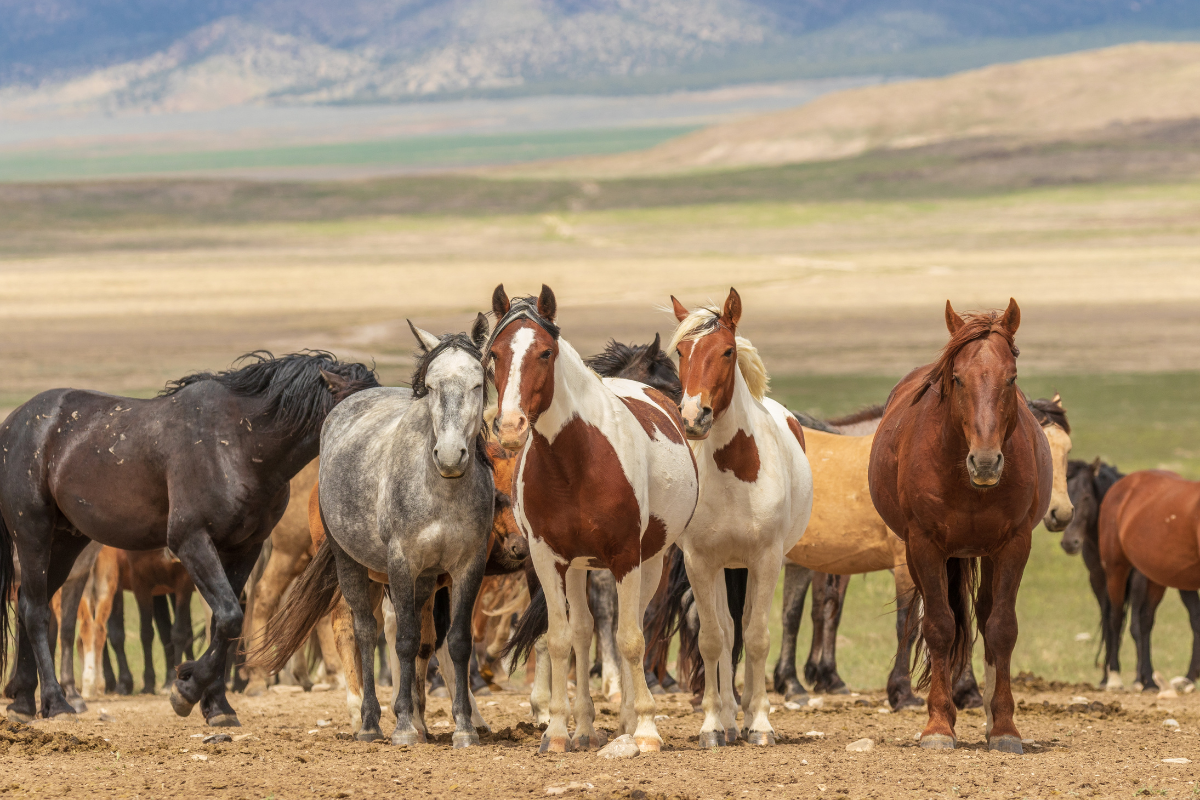By Jennifer Best
Located in the rugged and beautiful badlands of western North Dakota, Theodore Roosevelt National Park is currently home to some 200 wild horses, which the National Park Service (NPS) is proposing to restrict to a measly, unsustainable population of 35 to 60 animals or eliminate them altogether from the 70,000-acre property.
Friends of Animals has submitted comments to the NPS, joining roughly 20,000 people and organizations who wrote in opposition to this mismanagement plan. Only about 45 commenters supported the park’s unacceptable plan, reports Christine Kman, in a recent Washington Post editorial, “We can save North Dakota’s wild horses.”
Regrettably, the misguided few in favor of eliminating wild horses from their native landscape includes ecologist George Wuerthner, who inappropriately argues that wild horses are a “feral,” non-native species and should be treated the same as the doomed cows and sheep raised and killed by the meat industry.
“The hair on the back of my neck stands up when someone derides wild horses by calling them ‘feral’ and makes them throw-aways by referring to them as livestock,” said Priscilla Feral, president of Friends of Animals. “What an ecologist.”
What Wuerthner and his ilk need to do is stop ignoring the scientific evidence that horses are wildlife native to North America. Wild horses originated in North America millions of years ago before dispersing around the globe. While some believe they may have been extirpated from North America around 10,000 years ago, there is a long, continuous fossil sequence of horses extending 55 million years in North America. Because they evolved here, they benefit native ecosystems across the U.S.
Notably, the federal government regularly reintroduces species to their historical range. Several species were reintroduced to Theodore Roosevelt National Park after they had been extirpated from the area, including pronghorn antelope, bison, elk and bighorn sheep. In fact, NPS policy is to restore extirpated native plant and animal species to parks where adequate habitat to support the species exists or can be reasonably restored.
“The family Equidae evolved on this continent; it is as American as anything you could possibly imagine,” Dr. Ross MacPhee, the curator of mammalogy/vertebrate zoology at the American Museum of Natural History, stated in response to a “myth” posted on the Bureau of Land Management’s website that horses are native species.
The BLM is a mouthpiece for the meat industry, which was responsible for killing more than one million animals, including wolves, coyotes and bobcats in 2021. And that killing spree is typical every year as the U.S. Department of Agriculture’s Wildlife Services unit slaughters native wildlife to “protect” cattle and sheep.
In fact, multiple experts have found that “the non‐native, feral and exotic designations given by agencies are not merely reflections of their failure to understand modern science but also a reflection of their desire to preserve old ways of thinking to keep alive the conflict between a species [wild horses] . . . and the economic value of commercial livestock.”
Wild horses are ecosystem engineers
E-DNA collected from soil shows that native wild horses were still roaming North America as recently as 6,000 years ago. The Bering Strait land bridge allowed horses and other Pleistocene megafauna to migrate to and from continents. Horses that originated in North America were thus able to populate Eurasia. Some researchers, such as Yvette Running Horse Collin of the University of Alaska Fairbanks, cite scientific evidence along with traditional knowledge and information from Indigenous Peoples of the Americas that indicates wild horses were never extirpated from the Americas and continued to survive here as Spanish conquistadors and other European explorers arrived with their own horses in tow.
Native plants and animals have adapted in response to changes in the physical and biological characteristics of their region, allowing them to form intricate relationships and making them uniquely suited to life in their native habitat. For example, equids can use their hooves to dig more than six feet deep to reach groundwater. This activity creates oases that serve as a boon to other wildlife. Equid wells can also function as germination nurseries for riparian pioneer trees. Thus, wild horses have the potential to reduce the impacts of climate change and rising temperature on biodiversity and ecosystem function.
Wild horses also help spread plant seeds over large areas and do not decompose the vegetation they ingest as thoroughly as ruminant grazers, such as cattle or sheep, which allows the seeds of many plant species to pass through their digestive tract intact into the soil that the wild horses fertilize by their droppings. Wild horses help to prevent catastrophic fires, which are on the rise due to climate change, and help to build more moisture-retaining soils.
Wild horses select preferred grasses, sedges and herbs, including coarse, highly abrasive grasses, creating a mosaic of high and low vegetation that creates a more diverse habitat for invertebrates, small vertebrates and herbaceous plants. Unlike domestic cattle, wild horses do not stay at water sources, but rather move after drinking and will travel long distances from water. In contrast, livestock generally congregate and stay near water sources, causing damage to riparian ecosystems.
Park Superintendent Angie Richman has said a decision on thinning or eliminating the Theodore Roosevelt herd will come by the end of 2024. Rest assured, Friends of Animals will consider legal action if NPS decides to remove the horses and ignores evidence about wild horses being native to North America.

